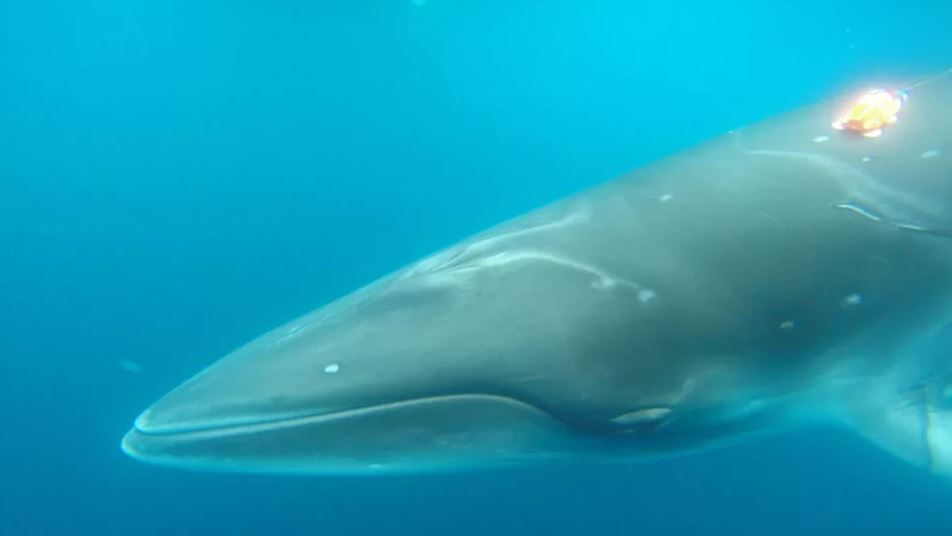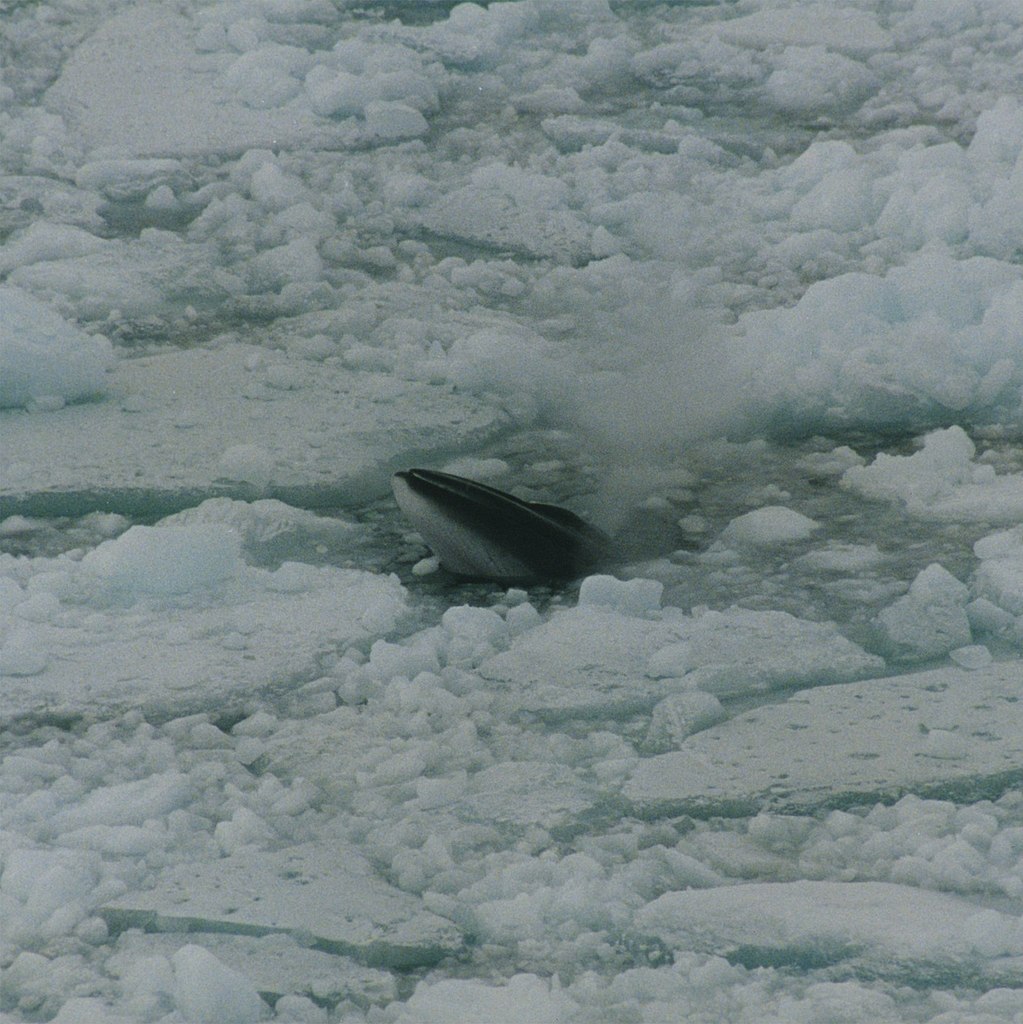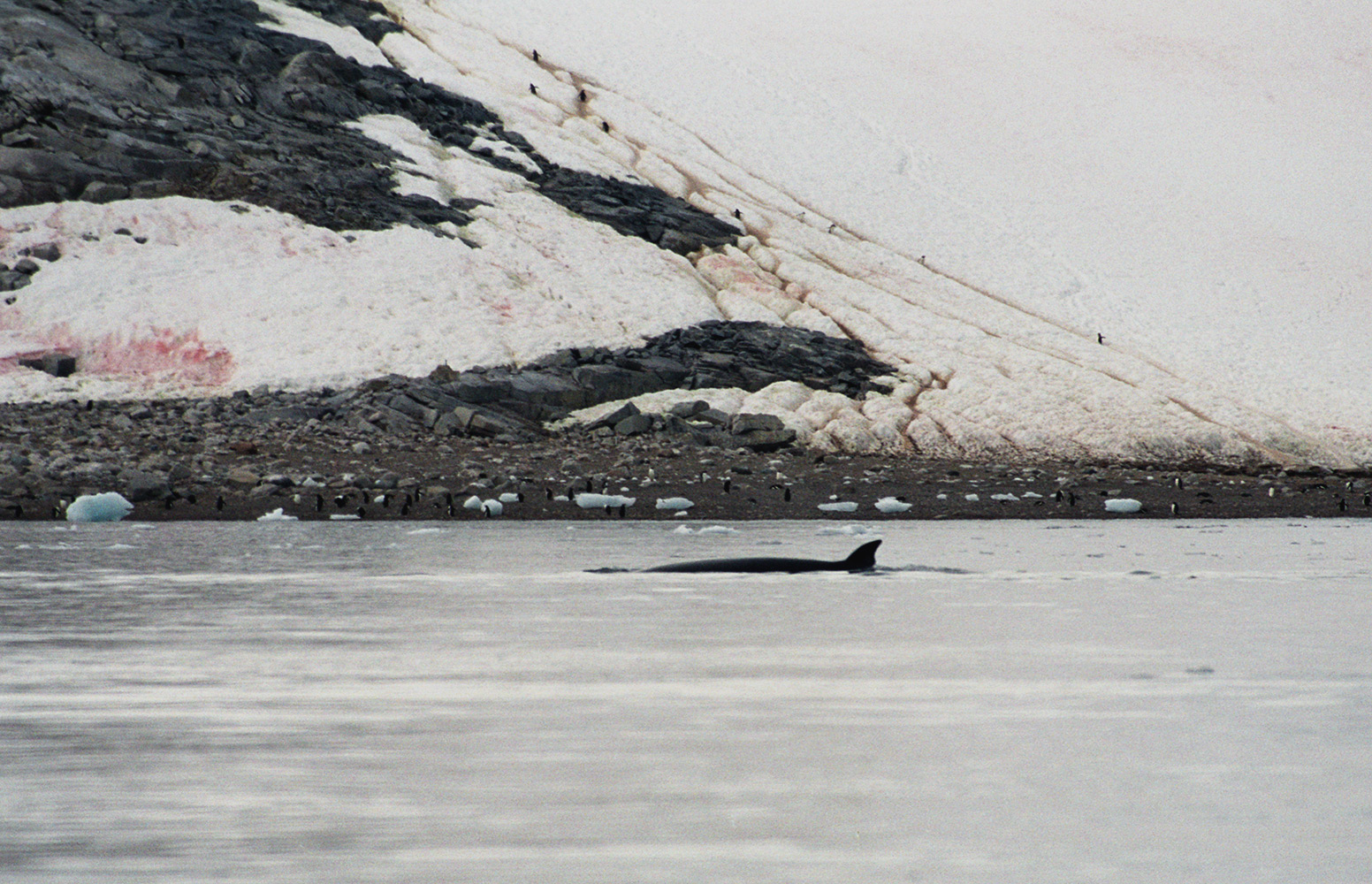Minke whale
The Antarctic minke whale or southern minke whale (Balaenoptera bonaerensis) is a species of minke whale within the suborder of baleen whales. It is the second smallest rorqual after the common minke whale and the third smallest baleen whale. Although first scientifically described in the mid-19th century, it was not recognized as a distinct species until the 1990s. Once ignored by the whaling industry due to its small size and low oil yield, the Antarctic minke was able to avoid the fate of other baleen whales and maintained a large population into the 21st century, numbering in the hundreds of thousands. Surviving to become the most abundant baleen whale in the world, it is now one of the mainstays of the industry alongside its cosmopolitan counterpart the common minke. It is primarily restricted to the Southern Hemisphere (although vagrants have been reported in the North Atlantic) and feeds mainly on euphausiids.
History
In February 1867, a fisherman found an estimated 9.75 m (32.0 ft) male rorqual floating in the Río de la Plata near Belgrano, about ten miles from Buenos Aires, Argentina. After bringing it ashore he brought it to the attention of the German Argentine zoologist Hermann Burmeister, who described it as a new species, Balaenoptera bonaerensis, the same year. The skeleton of another specimen, a 4.7 m (15 ft) individual taken off Otago Head, South Island, New Zealand, in October 1873, was sent by Professor Frederick Wollaston Hutton, keeper of the Otago Museum in Dunedin, to the British Museum in London, where it was examined by the British zoologist John Edward Gray, who described it as a new species of "pike whale" (minke whale, B. acutorostrata) and named it B. huttoni. Both descriptions were largely ignored for a century.
Gordon R. Williamson was the first to describe a dark-flippered form in the Southern Ocean, based on three specimens, a pregnant female taken in 1955 and two males taken in 1957, all brought aboard the British factory ship Balaena. All three had uniformly pale gray flippers and bicolored baleen, with white plates in the front and gray plates in the back. In the 1970s osteological and morphological studies suggested it was at least a subspecies of the common minke whale. In the 1980s further studies based on external appearance and osteology suggested there were in fact two forms in the Southern Hemisphere, a larger form with dark flippers and a "diminutive" or "dwarf form" with white flippers, the latter of which appeared to be more closely related to the common form of the Northern Hemisphere. This was strengthened by genetic studies using allozyme and mitochondrial DNA analyses, which proposed there were at least two species of minke whale, B. acutorostrata and B. bonaerensis, with the dwarf form being more closely related to the former species. One study, in fact, suggested that sei whales and the offshore form of Bryde's whale were more closely related to one another than either species of minke whale were to each other. The American scientist Dale W. Rice supported these conclusions in his seminal work on marine mammal taxonomy, giving what he called the "Antarctic minke whale" full specific status – this was followed by the International Whaling Commission a few years later. Other organizations followed suit.
Divergence
Antarctic and common minke whales diverged from each other in the Southern Hemisphere 4.7 million years ago, during a prolonged period of global warming in the early Pliocene which disrupted the Antarctic Circumpolar Current and created local pockets of upwelling, facilitating speciation by fragmenting populations.
Hybrids
There have been two confirmed hybrids between Antarctic and common minke whales. Both were caught in the northeastern North Atlantic by Norwegian whaling vessels. The first, an 8.25 m (27.1 ft) female taken off western Spitsbergen (78°02′N 11°43′E) on 20 June 2007, was the result of a pairing between a female Antarctic minke and a male common minke. The second, a pregnant female taken off northwestern Spitsbergen (79°45′N 9°32′E) on 1 July 2010, on the other hand, had a common minke mother and an Antarctic minke father. Her female fetus, in turn, was fathered by a North Atlantic common minke, demonstrating that back-crossing is possible between hybrids of the two species.
Description
Size
The Antarctic minke is among the smallest of the baleen whales, with only the common minke and the pygmy right whale being smaller. The longest caught off Brazil were an 11.9 meters (39.0 feet) female taken in 1969 and an 11.27 meters (37.0 feet) male taken in 1975, the former four feet longer than the second longest females and the latter five feet longer than the second longest males. Off South Africa, the longest measured were a 10.66 meters (35.0 feet) female and a 9.75 meters (32.0 feet) male. The heaviest caught in the Antarctic were a 9 meters (29.5 feet) female that weighed 10.4 metric tons (11.5 short tons) and an 8.4 meters (27.6 feet) male that weighed 8.8 metric tons (9.7 short tons).
At physical maturity, females average 8.9 meters (29.2 feet) and males 8.6 meters (28.2 feet). At sexual maturity, females average 8.1 meters (26.6 feet) and males 7.6 meters (24.9 feet). Calves are estimated to be 2.73 meters (8.96 feet) at birth.
External appearance
Like their close relative the common minke, the Antarctic minke whale is robust for its genus. Antarctic minkes lack the light gray rostral saddle present in the common and dwarf forms. All individuals possess pale, thin blowhole streaks trailing from the blowhole slits, which first veer left and then right – particularly the right streak. These streaks appear to be more prominent and consistent on this species than on either the common or dwarf minke. Most also have a variably colored – light gray, light gray with dark edges, or simply dark – ear streak trailing behind the opening for the auditory meatus, which widens and becomes more diffuse posteriorly. A light gray variably shaped double chevron or W-shaped pattern (analogous to a similar pattern seen on their larger cousin the fin whale) lies between the flippers. This broadens to form a light gray shoulder patch above the flippers. Like common and dwarf minkes, they have two light gray to whitish swaths, called the thorax and flank patches, the former running diagonally up from the axilla and diagonally down again to form a triangular intrusion into the dark gray of the thorax and the latter rising more vertically along its anterior edge and extending further dorsally before gradually sloping posteriorly to merge with the white of the ventral side of the caudal peduncle. A dark gray, roughly triangular thorax field separates the two, while a narrower dark gray shoulder infill separates the thorax patch from the shoulder patch. Two light gray, forward directed caudal chevrons extend from the dark gray field above, forming a whitish peduncle blaze between them. The smooth sided flukes, usually about 2.6 to 2.73 m (8.5 to 9.0 ft) wide, are dark gray dorsally and clean white (occasionally light gray to gray) ventrally with a thin, dusky margin. Some small, dark gray speckling may be present on the body.
Antarctic minkes lack the bright white, transverse flipper band of the common minke and the white shoulder blaze and bright white flipper patch (occupying the proximal two-thirds of the flipper) of the dwarf minke. Instead, their narrow, pointed flippers, about one-sixth to one-eighth of the total body length, are normally either a plain light gray with an almost white leading edge and a darker gray trailing edge or two-toned, with a thin light gray or dark band separating the darker gray of the proximal third of the flipper from the lighter gray of the distal two-thirds. Unlike the dwarf minke, the dark gray between the eye and flipper does not extend unto the ventral grooves of the throat to form a dark throat patch; there is instead an irregularly shaped line running from about the level of the eye to the anterior insertion of the flipper, merging with the light gray of the shoulder patch.
Distribution
Antarctic minke whales occur throughout much of the Southern Hemisphere. Vagrants have been reported in Suriname – an 8.2 meters (26.9 feet) female was killed 45 km (28 mi) upstream the Coppename River in October 1963; the Gulf of Mexico, where a 7.7 meters (25.3 feet) female was found dead off the U.S. state of Louisiana in February 2013; and off Jan Mayen (June) in the northeastern North Atlantic.
They appear to disperse into offshore waters during the breeding season. In the spring (October–December), Japanese sighting surveys from 1976 to 1987 recorded relatively high encounter rates of minke whales off South Africa and Mozambique (20° – 30°S, 30° – 40°E), off Western Australia (20° – 30°S, 110° – 120°E), around the Gambier Islands of French Polynesia (20° – 30°S, 130° – 140°W), and in the eastern South Pacific (10° – 20°S, 110° – 120°W). Later surveys, which distinguished between Antarctic and dwarf minke whales, showed that most of these were Antarctic minke whales.
They have a circumpolar distribution in the Southern Ocean (where they have been recorded year-round), including the Bellingshausen Sea, Weddell Sea, and Ross Sea. They are most abundant in the MacKenzie Bay-Prydz Bay area (60° – 80°E, south of 66°S) and relatively numerous off Queen Maud Land. Like their larger cousin the blue whale, they have a particular affinity for the pack ice. In the spring (October–November), they occur widely throughout the pack ice zone to near the edge of the fast ice, where they have been observed between belts of pack ice and in leads and polynyas – often in heavy ice cover. Some individuals have become trapped in the ice and were forced to overwinter in the Antarctic – for example, up to 120 "lesser rorquals" were trapped in a small breathing hole with sixty killer whales and an Arnoux's beaked whale in Prince Gustav Channel, east of the Antarctic Peninsula and west of James Ross Island, in August 1955.
Migration and movements
Two Antarctic minke whales marked with "Discovery tags" – 26 cm (10 in) stainless steel tubes with an inscription and number engraved on them – in the Southern Ocean during the austral summer (January) were recovered a few years later off northeastern Brazil (6° – 7°S, 34°W) during the austral winter (July and September, respectively). The first was marked off Queen Maud Land (69°S 19°E) and the second southeast of the South Orkney Islands (62°S 35°W). Over twenty individuals marked with these Discovery tags showed large-scale movements around the Antarctic continent, each moving more than 30 degrees of longitude – two, in fact, had moved over 100 degrees of longitude. The first was marked off the Adélie Coast (66°S 141°E) and recovered the following season off the Princess Ragnhild Coast (68°S 26°E), a minimum of 114 degrees of longitude. The second was marked north of Cape Adare (68°S 172°E) and recovered nearly six years later northwest of the Riiser-Larsen Peninsula (68°S 32°E), a minimum of over 139 degrees of longitude. Both were marked and recovered in January.
On 20 January 1972, a 49.5 cm (19.5 in) broken-off bill of a marlin was found embedded in the rostrum of a minke whale caught in the Southern Ocean at 64°06′S 87°14′E, providing indirect evidence of migration to the warmer tropical or subtropical waters of the Indian Ocean.
Population
Earlier estimates suggested that there were several hundred thousand minke whales in the Southern Ocean. In 2012, the Scientific Committee of the International Whaling Commission agreed upon a best estimate of 515,000. The Report of the Scientific Committee acknowledged that this estimate is subject to some degree of negative bias because some minke whales would have been outside the surveyable ice edge boundaries.
Prey and Predation
Antarctic minke whales feed almost exclusively on euphausiids. In the Southern Ocean, over 90% of individuals fed on Antarctic krill. Rare and incidental items include the pelagic amphipod Themisto gaudichaudii, Antarctic sidestripes, and the crocodile icefish. The majority of individuals examined off South Africa had empty stomachs.
Antarctic minke whales are the main prey item of Type A killer whales in the Southern Ocean. Their remains have been found in the stomachs of killer whales caught by the Soviets, while individuals caught by the Japanese exhibited damaged flippers with tooth rake scars and parallel scarring on the body suggestive of killer whale attacks. Large groups of killer whales have also been observed chasing, attacking, and even killing Antarctic minke whales. Most attacks involve Type A killer whales, but on one occasion, in January 2009, a group of ten Type B or pack ice killer whales, which normally preyed on Weddell seals in the area by wave-washing them off ice floes, were observed to attack, kill, and feed on a juvenile Antarctic minke whale in Laubeuf Fjord, between Adelaide Island and the Antarctic Peninsula.


